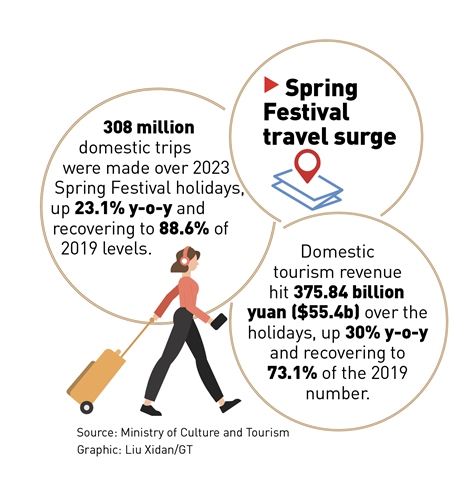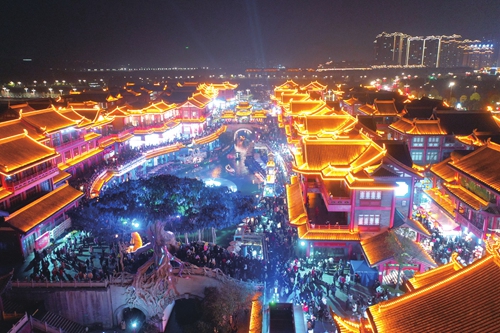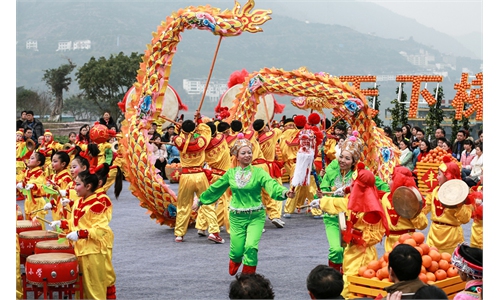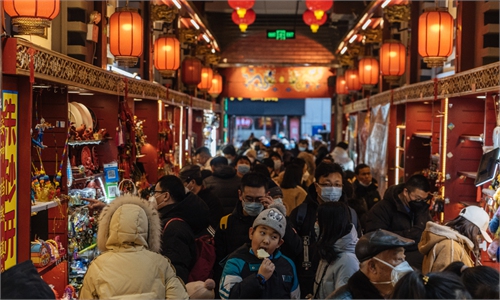Hometown Witness: 'Revenge' holiday spending seen nationwide, as people pack streets, markets
Almost every city center in China was filled with a sea of people during the Spring Festival holidays in 2023, with long queues seen outside restaurants, malls and scenic spots. Fireworks were seen illuminating the sky in some Chinese cities. Traditional lion dances, dragon dances, temple fairs and many other Chinese New Year activities made a grand comeback.
The festival, which falls on January 21 to 27 this year, was finally able to play its original role of family reunion after a year of hard work, a custom that had been greatly disrupted by COVID-19 in the past three years.
Since the government moved to optimize COVID management in December, this Spring Festival has been the liveliest in three years, according to observations by Global Times reporters going home for the festival, who are scattered in many medium and small-sized cities in the country. And, the reporters have also spotted significant changes in their hometowns.

One of the changes was seen in transportation. Thanks to the construction of the country's 42,000-km-long high-speed trains system which crisscrosses the whole country, it is now much easier and faster for people to buy a ticket and dash back to their hometowns.
For example, it used to take 36 hours from Beijing to Suifenhe, a small China-Russia border city in Northeast China's Heilongjiang Province, in 1995 by the old-fashioned train. The travel time is now shortened to only eight hours over more than 1,300 kilometers.
And, the high-speed railway between Beijing and Harbin, capital city of Heilongjiang started operations on January 22, 2021, during the outbreak of COVID-19.
The same improvement is seen in Ulanqab, a small city in North China's Inner Mongolia Autonomous Region, where people who used to have to sleep on the train can now complete their journey in just two hours by taking a high-speed train.
These are just a few of the hundreds of small cities in China that have benefited greatly from more convenient transportation, not only for personal travel, but also for shipping goods.
At the IGOR Russian Goods Market in Suifenhe on January 19, two days before the Chinese Lunar New Year, businessmen were seen busy packing parcels that were to be sent to clients all over China via advanced e-commerce services. The rapid development of the transport network has allowed the small border town to hop on the e-commerce express train to ship Russian goods across China.
"I will work until Chinese New Year's Eve. Our shop still has many packages to wrap up and deliver," a shopkeeper at IGOR told a Global Times reporter on January 19. "There are just too many orders."
Huge pent-up spending
Hectic online shopping is just one aspect of the obvious "revenge spending" seen across the country during the holidays. Since it is the first Spring Festival after China optimized its anti-COVID response, pent-up spending has kept soaring since early January.
Also, outdoor markets in small cities and villages continue to be hot destinations prior to the Spring Festival thanks to low prices, according to Global Times reporters.
For example, at the Longxugou market in Suifenhe, premium products such as lobsters, sea cucumbers and crabs were selling particularly well. Freezing temperatures of -20 C did not deter local residents from purchasing New Year goods at the street markets there. Shopping malls, cinemas and many other indoor venues were also filled with swarms of people.

A taxi driver in Southwest China's Chongqing city told the Global Times on Wednesday that he had not taken a break since Chinese New Year's Eve on January 21.
"I earned 1,500 yuan ($222) on New Year's Eve and worked every day during the Spring Festival holidays," said the driver.
In Chongqing, several tourist attractions were filled with people, with long queues outside restaurants and popular pubs seen everywhere. The shortest queuing time for popular tea brand Chayan Yuese was 40 minutes, the Global Times learned.
A Beijing resident surnamed Xu who traveled to Chongqing during the holidays told the Global Times on Thursday that he was No 364 in line for a two-seat table at a famous hotpot restaurant.
"Apart from waiting in line for half an hour when I arrived in Chongqing on January 19, in the following days, I could only eat in the hotel, because at almost every restaurant you had to wait behind 200 tables," said Xu.
Xu is not the only one who complained about long waiting times. According to a post on social media platform Sina Weibo, a netizen was No 4,538 in line for Wenheyou, a popular restaurant in Changsha city, Central China's Hunan Province.
Some netizens said that they failed to taste any local food during the Spring Festival and were forced to eat instant noodles, as every restaurant had endless queues.
While domestic scenic spots were crowded, many Chinese tourists went abroad to enjoy Spring Festival holidays. Overall outbound travel orders soared 640 percent year-on-year during the holidays on online travel agency trip.com, the platform said on Friday.
For many people, a Spring Festival without the sound of firecrackers lacks a true festive atmosphere. This year, beautiful fireworks again lit up the skies in many parts of China after years of being banned.
The festival, which falls on January 21 to 27 this year, was finally able to play its original role of family reunion after a year of hard work, a custom that had been greatly disrupted by COVID-19 in the past three years.
Since the government moved to optimize COVID management in December, this Spring Festival has been the liveliest in three years, according to observations by Global Times reporters going home for the festival, who are scattered in many medium and small-sized cities in the country. And, the reporters have also spotted significant changes in their hometowns.

One of the changes was seen in transportation. Thanks to the construction of the country's 42,000-km-long high-speed trains system which crisscrosses the whole country, it is now much easier and faster for people to buy a ticket and dash back to their hometowns.
For example, it used to take 36 hours from Beijing to Suifenhe, a small China-Russia border city in Northeast China's Heilongjiang Province, in 1995 by the old-fashioned train. The travel time is now shortened to only eight hours over more than 1,300 kilometers.
And, the high-speed railway between Beijing and Harbin, capital city of Heilongjiang started operations on January 22, 2021, during the outbreak of COVID-19.
The same improvement is seen in Ulanqab, a small city in North China's Inner Mongolia Autonomous Region, where people who used to have to sleep on the train can now complete their journey in just two hours by taking a high-speed train.
These are just a few of the hundreds of small cities in China that have benefited greatly from more convenient transportation, not only for personal travel, but also for shipping goods.
At the IGOR Russian Goods Market in Suifenhe on January 19, two days before the Chinese Lunar New Year, businessmen were seen busy packing parcels that were to be sent to clients all over China via advanced e-commerce services. The rapid development of the transport network has allowed the small border town to hop on the e-commerce express train to ship Russian goods across China.
"I will work until Chinese New Year's Eve. Our shop still has many packages to wrap up and deliver," a shopkeeper at IGOR told a Global Times reporter on January 19. "There are just too many orders."
Huge pent-up spending
Hectic online shopping is just one aspect of the obvious "revenge spending" seen across the country during the holidays. Since it is the first Spring Festival after China optimized its anti-COVID response, pent-up spending has kept soaring since early January.
Also, outdoor markets in small cities and villages continue to be hot destinations prior to the Spring Festival thanks to low prices, according to Global Times reporters.
For example, at the Longxugou market in Suifenhe, premium products such as lobsters, sea cucumbers and crabs were selling particularly well. Freezing temperatures of -20 C did not deter local residents from purchasing New Year goods at the street markets there. Shopping malls, cinemas and many other indoor venues were also filled with swarms of people.

Travelers flood a waterfront attraction in Meishan, Southwest China's Sichuan Province on the evening of January 22, 2023, the first day of the Chinese Lunar New Year. Photo: cnsphoto
A taxi driver in Southwest China's Chongqing city told the Global Times on Wednesday that he had not taken a break since Chinese New Year's Eve on January 21.
"I earned 1,500 yuan ($222) on New Year's Eve and worked every day during the Spring Festival holidays," said the driver.
In Chongqing, several tourist attractions were filled with people, with long queues outside restaurants and popular pubs seen everywhere. The shortest queuing time for popular tea brand Chayan Yuese was 40 minutes, the Global Times learned.
A Beijing resident surnamed Xu who traveled to Chongqing during the holidays told the Global Times on Thursday that he was No 364 in line for a two-seat table at a famous hotpot restaurant.
"Apart from waiting in line for half an hour when I arrived in Chongqing on January 19, in the following days, I could only eat in the hotel, because at almost every restaurant you had to wait behind 200 tables," said Xu.
Xu is not the only one who complained about long waiting times. According to a post on social media platform Sina Weibo, a netizen was No 4,538 in line for Wenheyou, a popular restaurant in Changsha city, Central China's Hunan Province.
Some netizens said that they failed to taste any local food during the Spring Festival and were forced to eat instant noodles, as every restaurant had endless queues.
While domestic scenic spots were crowded, many Chinese tourists went abroad to enjoy Spring Festival holidays. Overall outbound travel orders soared 640 percent year-on-year during the holidays on online travel agency trip.com, the platform said on Friday.
For many people, a Spring Festival without the sound of firecrackers lacks a true festive atmosphere. This year, beautiful fireworks again lit up the skies in many parts of China after years of being banned.



